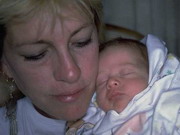By Michael Dorausch, D.C.
The Centers for Disease Control and Prevention (CDC) reports that 3 out of 4 new moms in US now breast-feed their infants. That’s the highest rate in the U.S. since the 1980’s, according to a CDC/National Center for Health Statistics report released Wednesday.
According to the report, nearly 80 percent of new mothers breast-feed, at least briefly, up from 60 percent in 1993-1994.
 Human milk is the ideal food for most infants. Breastfeeding benefits infants and their mothers. Breastfed infants receive anti-bodies from breast milk, which protect against infection in the early postpartum period, and breastfeeding is less expensive than formula feeding. The report summarizes information on breastfeeding rates in the United States based on data from the 1999-2006 National Health and Nutrition Examination Surveys (NHANES). Results are reported for the total U.S. population and three race-ethnic groups by birth year cohort.
Human milk is the ideal food for most infants. Breastfeeding benefits infants and their mothers. Breastfed infants receive anti-bodies from breast milk, which protect against infection in the early postpartum period, and breastfeeding is less expensive than formula feeding. The report summarizes information on breastfeeding rates in the United States based on data from the 1999-2006 National Health and Nutrition Examination Surveys (NHANES). Results are reported for the total U.S. population and three race-ethnic groups by birth year cohort.
Breastfeeding rates were examined by income status group. Income status was defined using the poverty income ratio (PIR), an index calculated by dividing family income by a poverty threshold that is specific for family size. Low income was defined as PIR less than or equal to 1.85, and high income was defined as PIR greater than 1.85. For the total population, the proportion of infants who were ever breastfed was lower among infants whose families had lower income compared with infants whose families had higher income status.
According to the report, the differences in breastfeeding rates by family income status were only observed among non-Hispanic white and non-Hispanic black infants, but not among Mexican-American infants.
Within each income group, the breastfeeding rates for non-Hispanic black infants were significantly lower compared with the breastfeeding rates among non-Hispanic white and Mexican-American infants. Infants whose mothers were younger were less likely to have been breastfed.
Breastfeeding rates increased significantly with increasing maternal age overall and for all race-ethnicity groups. The breastfeeding rates of mothers who were under 20 years of age were lower compared with mothers who were 30 years and older or 20-29 years of age.
Diet is an integral component of infant and child growth and development, and healthy feeding practices have benefits that continue into childhood and adolescence.
You can access the NCHS Data Brief to learn more about the findings.
A few Planet Chiropractic related articles include Breast-Feeding & Good Health, Better mental health for breastfed babies, and an Interview with Jennifer Laycock of The Lactivist.
planetc1.com-news @ 5:37 pm | Article ID: 1209602285




Comments are closed for this article!